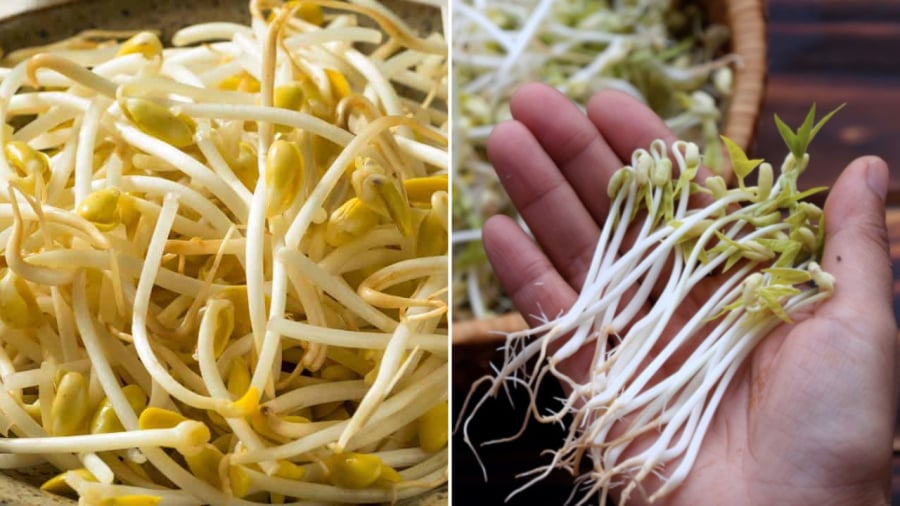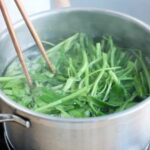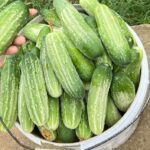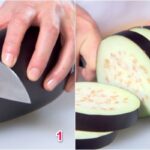Bean sprouts are a highly nutritious food, used in a variety of dishes. They can be eaten raw, in salads, pickled, in soups, stir-fried, or hot pot, and are a popular ingredient in many Asian cuisines. One of the most common dishes made with bean sprouts is stir-fried sprouts. You can stir-fry them with scallions or combine them with beef or pork.
When stir-frying bean sprouts, a common issue is that they can become soggy and watery. To avoid this, consider the following tips for a perfect dish.
Selecting the Best Bean Sprouts
First, to ensure a delicious dish, it is essential to choose the freshest bean sprouts. If purchasing them from a market, carefully examine them to avoid those treated with growth stimulants.
Naturally grown bean sprouts tend to have longer roots. In contrast, sprouts treated with growth stimulants will have very short roots or even none at all. When soaked in chemicals, all parts of the sprout absorb water, resulting in underdeveloped roots.

Carefully select your bean sprouts to avoid those treated with growth stimulants.
Naturally grown sprouts take longer to develop, so the sprouted leaves are usually green or yellow. In contrast, chemically treated sprouts develop rapidly, with the two seeds still tightly closed, and the leaves underdeveloped, while the stems are already long.
Typically, bean sprouts are pale white or creamy in color. Avoid buying overly white or plump sprouts, as they are likely treated with chemicals.
Additionally, it is easy to grow your own bean sprouts at home. Simply purchase the beans and sprout them yourself to ensure safety and freshness.
Preparing the Bean Sprouts
Before cooking, it is essential to clean the bean sprouts thoroughly. As they may be grown in damp sand, multiple rinses are necessary to remove any residual sand and bean husks.
For added caution, you can also trim the longer roots of the sprouts.
Tips for Stir-Frying Bean Sprouts Without Soggy Results
– Soak in Diluted Vinegar
After rinsing, prepare a bowl of diluted vinegar by mixing water with a small amount of white vinegar. Soak the sprouts in this solution for about 10 minutes, then rinse them again with clean water. This process helps clean and brighten the sprouts while preventing excess water release during stir-frying. Make sure to drain the sprouts well after rinsing.
– Chill in the Fridge
Another tip to enhance crispness and reduce water release is to place the rinsed sprouts in the refrigerator for 10-15 minutes before stir-frying. Then, take them out and proceed to cook.
– Blanching in Boiling Water
Before stir-frying, you can also blanch the sprouts in boiling water to prevent sogginess. Prepare a pot of water with a pinch of salt and bring it to a boil. Add the sprouts and stir gently. Blanch for only 5-7 seconds, then remove them immediately to avoid overcooking. After blanching, immerse the sprouts in cold water to cool them completely, then drain and proceed to stir-fry.
Notes on Stir-Frying Bean Sprouts

When stir-frying bean sprouts, pay attention to ensure they are cooked just right without becoming mushy.
Bean sprouts cook quickly, so there is no need to stir-fry them for an extended period. Use high heat and stir continuously to ensure even cooking without sogginess.
If stir-frying bean sprouts with other vegetables or meat, it is advisable to cook each ingredient separately until just done and then mix them together. This ensures that all components are cooked evenly.
The Secret to Perfectly Crisp and Tasty Stir-fried Vegetables
Here’s a mouth-watering tip to transform your stir-fried veggies into a restaurant-worthy dish. This simple trick will ensure your veggie plate is the first to be devoured during mealtime.
The Ultimate Guide to Eggplant Preparation: A Chef’s Secrets Unveiled
The aubergine, or eggplant, is a versatile vegetable with a unique taste and texture. This article will reveal tips and tricks to prepare and cook aubergine to perfection, enhancing its natural sweetness and reducing any bitterness. Discover the secrets to unlocking the full potential of this nutritious vegetable with our expert guide.






































